 Washington, Jan 29: A new review of tsunami hazards has revealed that the catastrophe that happened in the Indian Ocean in 2004 was not the worst yet and that an even bigger tsunami might possibly occur in the future.
Washington, Jan 29: A new review of tsunami hazards has revealed that the catastrophe that happened in the Indian Ocean in 2004 was not the worst yet and that an even bigger tsunami might possibly occur in the future.Let us bow our heads in respect and remembrance of this tragic day in modern history. The skies have shown their compassion thru the rain. It has been raining the whole day
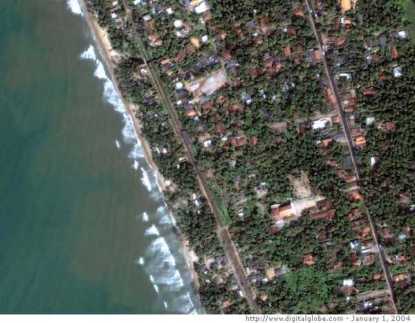
Sri Lanka before the tsunami
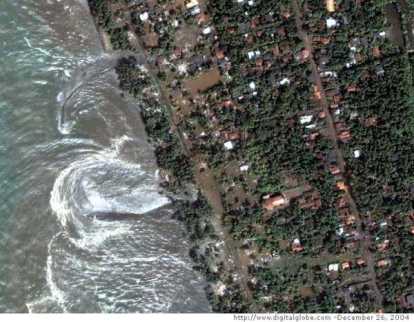
Sri Lanka after the tsunami
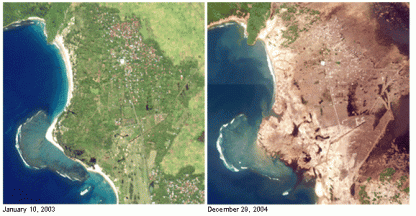
Another before-after comparison
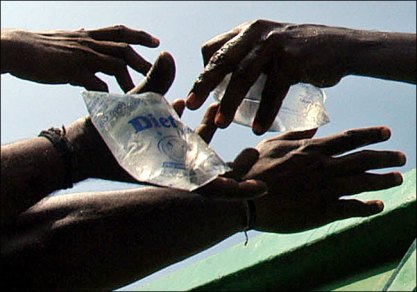
Aid for those affected. Somehow, this picture really moved me. Hands stretching out to help those in need…
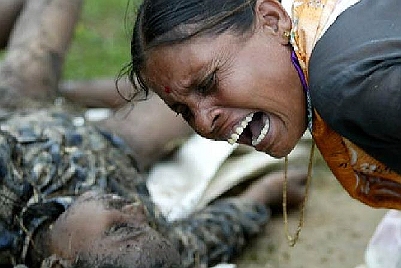
The cries of a mother
No tears left
2004 Tsunami: How Foodies Can Help

What can we do to aid the victims of the 2004 Tsunami, whose 9.0 underwater quake began offshore of Indonesia on the morning of December 26, 2004? Individually, we can do little -- but together, well channeled, just a little from each of us can do a lot. I am calling on all Foodies to make donations (below) to aid agencies -- online, whatever the amount, right now. I am asking that you also please link this message to any and all food blogs and beyond to other blogs, on and on, in attempt to tell others how they can help right now. Take $10 out of your groceries and/or meals out and send it to one of these groups. Don't doubt that even a few dollars help -- because the world's leading nation, the United States of America, had offered only $35 million in aid as of the close of business yesterday, December 28, 2004, according to a television interview with US Secretary of State Colin Powell.

The death toll of the 2004 Tsunami has risen daily by the tens of thousands. In case you missed the news, the death toll during yesterday evening's TV news programs was proclaimed at over 60,000 people (News Hour, NBC, ABC, CBS), topping last year's earthquake in Bam, Iran, whose final count exceeded 25,000. This morning, the Red Cross expected the figure to surpass 100,000 deaths. The death-toll lag has come from the country nearest the underwater epicenter of the earthquake, Indonesia. Politics will play a part in aid, since countries like Indonesia and Sri Lanka have problems with their effected peoples, e.g., Indonesia's Acehnese and Sri Lanka's Tamils, which are both separatist groups.

Put this into perspective: this earthquake was so big that it shifted islands off Indonesia and even made the Earth wobble. Just days after the tsunami, drinking water has hit the top of the needs list of many. Aid agencies and nations are racing to undertake the largest humanitarian relief effort in history (read more from The News Hour). A follow-up crisis is brewing in the form of disease and starvation

What can we do to aid the victims of the 2004 Tsunami, whose 9.0 underwater quake began offshore of Indonesia on the morning of December 26, 2004? Individually, we can do little -- but together, well channeled, just a little from each of us can do a lot. I am calling on all Foodies to make donations (below) to aid agencies -- online, whatever the amount, right now. I am asking that you also please link this message to any and all food blogs and beyond to other blogs, on and on, in attempt to tell others how they can help right now. Take $10 out of your groceries and/or meals out and send it to one of these groups. Don't doubt that even a few dollars help -- because the world's leading nation, the United States of America, had offered only $35 million in aid as of the close of business yesterday, December 28, 2004, according to a television interview with US Secretary of State Colin Powell.

The death toll of the 2004 Tsunami has risen daily by the tens of thousands. In case you missed the news, the death toll during yesterday evening's TV news programs was proclaimed at over 60,000 people (News Hour, NBC, ABC, CBS), topping last year's earthquake in Bam, Iran, whose final count exceeded 25,000. This morning, the Red Cross expected the figure to surpass 100,000 deaths. The death-toll lag has come from the country nearest the underwater epicenter of the earthquake, Indonesia. Politics will play a part in aid, since countries like Indonesia and Sri Lanka have problems with their effected peoples, e.g., Indonesia's Acehnese and Sri Lanka's Tamils, which are both separatist groups.

Put this into perspective: this earthquake was so big that it shifted islands off Indonesia and even made the Earth wobble. Just days after the tsunami, drinking water has hit the top of the needs list of many. Aid agencies and nations are racing to undertake the largest humanitarian relief effort in history (read more from The News Hour). A follow-up crisis is brewing in the form of disease and starvation
| TOP | |
Environmental Geology of Developing Nations Photo Gallery |
Environmental Geology
of
Developing Nations
Geology 351
| Environmental Geology of Developing Nations (GEOL 351) is a 4-unit General Education course that creates an understanding of the role that the physical environment plays in the health and welfare of developing nations. The purpose of the course is to help students understand that the quality of planning will determine whether or not developing nations realize the benefits of their natural resources and reduce the impacts of natural disasters. This course satisfies part of the Upper Division Theme requirement of the General Education Program. Environmental Geology of Developing Nations is in Theme A: Challenge of Change in the Developing World |  The city of Quito is in the rapidly developing nation of Ecuador. Ecuador is challenged by its geological hazards and its natural resources. It has large reserves of natural gas that brings the petroleum industry and a beautiful landscape that is attractive to tourists. But Quito and other population centers are in earthquake zones and surrounded by active volcanoes. The future of Ecuador partly depends on wise management of its natural environment. The city of Quito is in the rapidly developing nation of Ecuador. Ecuador is challenged by its geological hazards and its natural resources. It has large reserves of natural gas that brings the petroleum industry and a beautiful landscape that is attractive to tourists. But Quito and other population centers are in earthquake zones and surrounded by active volcanoes. The future of Ecuador partly depends on wise management of its natural environment. | |||||||||||
| This is a lecture-only course. Students meet for 100-minute class periods twice a week. Grades are typically determined by 2 to 4 exams, a written or oral presentation, and class participation. The course is taught for General Education students and does not require a background in mathematics or science. Introductory concepts in geology are provided as each topic is discussed. | |||||||||||
| Class periods may be used for lectures, group discussions, demonstrations, or visual presentations. Typically Environmental Geology of Developing Nations is divided into two major topics: (1) the recognition, mitigation, and prevention of natural disasters in developing nations, and (2) the positive and negative aspects of natural resource extraction. Students work to understand these topics within the cultural, economic, and historic framework of developing nations. |  Mexico City was fairly far removed from the epicenter of the 1985 earthquake. In spite of this, the damage was very severe because of the soft, weak sediment that the city has been constructed upon. Poor construction increased the death toll. Mexico City was fairly far removed from the epicenter of the 1985 earthquake. In spite of this, the damage was very severe because of the soft, weak sediment that the city has been constructed upon. Poor construction increased the death toll. | |||||||||||
| The subject of this course has enduring and great importance for humanity. It addresses the physical environment of the largest portion of the world population. It is this environment and the human response to it that will determine many aspects of the future quality of life for all people on Earth. For example, wars are often fought for valuable resources including energy, minerals, and fertile soils. An understanding of the physical environment and its impact on human welfare is one step to a better and more peaceful future. Environmental ethics are part of the equation that students come to appreciate. | |||||||||||
| TOP | ||||||||||||
| The course opens with a study of population growth and dynamics and how it impacts developing nations. The population of developing nations will soon exceed 5 billion people and could reach 8 billion by the year 2025. You will come to recognize that population growth is deeply involved with the consequences of natural disasters and the development, use, and loss of natural resources. Understanding these impacts will provide you with a better understanding of the future of the largest portion of the world population. |  Starvation is far too common for many of the poorest people around the world. Starvation is far too common for many of the poorest people around the world. | |||||||||||
| This is followed by a focus on geological hazards. The 2004 Indian Ocean tsunami and the 2005 Pakistan earthquake demonstrate the horrific impact of earthquakes in developing regions. Students learn how earthquakes cause destruction and why the damage that they cause is often so much more severe in developing nations. Measures to reduce the consequences of earthquakes and barriers to implementation of these improvements in developing nations are explored. | |||||||||||
| United Nations studies show that the economic impact of landslides and land subsidence is astounding. Landslides take thousands of lives each year and do untold millions of dollars of damage around the world and yet no developing nation takes significant measures to reduce this cause of suffering. |  The Cathedral de Guadalupe of Mexico City has been gradually sinking into the soft sediment beneath the building. The Cathedral de Guadalupe of Mexico City has been gradually sinking into the soft sediment beneath the building. | |||||||||||
| TOP | ||||||||||||
| Land subsidence is a slow and insidious process that is often worsened by human activity. Locations near sea level, such as Bangladesh, suffer the worst consequences of subsidence. These areas face either the great cost of levees to hold back the ocean or loss of valuable land. | |||||||||||
| Soil erosion poses enormous threats to developing nations especially those with rapidly growing populations. Soil erosion is caused by wasteful farming practices, overgrazing by cattle and sheep, and road construction or housing developments. Soil erosion reduces agricultural production and threatens the sustainability of the population in many areas. Ways to lessen this threat to developing nations are discussed. |  Terracing in Indonesia enables farmers to raise rice crops without severe soil erosion. Terracing in Indonesia enables farmers to raise rice crops without severe soil erosion. | |||||||||||
| Volcanism and its attendant mudflows is an especially severe problem in Central and South America and Southeast Asia. Towns, villages, and even large cities are built in the immediate path of volcanic devastation. Case studies such as the 1985 destruction of Armero in Colombia and the loss of 23,000 lives will be presented. Students learn that it is important to plan for natural disasters rather than simply react to them. | |||||||||||
| TOP | ||||||||||||
| The final part of the course investigates renewable and nonrenewable resources of developing nations. The water cycle and human interference with it will be investigated. Case studies of water pollution, loss of groundwater resources, and interruption and redirection of surface flow will be presented. |  These Indonesians do their laundry, bathe, and often drink unsanitary water. United Nations studies show that the life in developing nations is often greatly improved by cleaning up polluted water. These Indonesians do their laundry, bathe, and often drink unsanitary water. United Nations studies show that the life in developing nations is often greatly improved by cleaning up polluted water. | |||||||||||
| One of the worst problems for developing nations is the loss of their quick assets - fossil fuels and metallic and nonmetallic resources. Quick assets are those that are quickly removed from the ground and sold for cash. The natural occurrence and consequences of the utilization of these resources will be studied. Wise use of these assets may greatly improve the fortune of the resource supplying nations. Foolish use will result in resentment. It is important that leaders understand the concepts of sustained yield, multiple land use, and good planning for future generations. | |||||||||||
| Knowledge of the natural environment of developing nations will give you a clearer understanding of world events as they unfold during your lifetime. Furthermore, you will develop a sense of community and awareness of the global interdependence of the human experience. It will be impossible for you to consider nature and its relationship to developing nations without also probing the ethical responsibilities that humans have to each other. This will be a course that has lasting value to you as you experience the complex web of human activities during your lifetime. |  These 15-year old Masai boys in Tanzania represent a culture that has taken great pride in its ability to preserve its traditional way of life. Look closely at what the boy in the center is holding in his left hand. It appears that even the Masai will change their way of life and place large demands on Earth's natural resources | |||||||||||
| ||||||||||||
| ||||||||||||
| ||||||||||||
| TOP | ||||||||||||
| ||||||||||||
| ||||||||||||




 Over 80,000 lives were lost in the Pakistan earthquake. Poor construction is often a result of poverty but the consequence during an earthquake may be total loss of homes and lives. The remoteness of mountain villages and the harsh weather made this earthquake far worse.
Over 80,000 lives were lost in the Pakistan earthquake. Poor construction is often a result of poverty but the consequence during an earthquake may be total loss of homes and lives. The remoteness of mountain villages and the harsh weather made this earthquake far worse. 
 Chile has over 600 volcanoes. Volcanoes create dangers but they have also fertilized the rich soils of Chile's central valley. Volcan Calbuco near Puerto Mont can be seen in the distance in this photo.
Chile has over 600 volcanoes. Volcanoes create dangers but they have also fertilized the rich soils of Chile's central valley. Volcan Calbuco near Puerto Mont can be seen in the distance in this photo.  This photo was taken in an iron ore mine in South Africa. South Africa is extraordinarily rich in mineral resources and supplies many of the important metals that we need for our modern life.
This photo was taken in an iron ore mine in South Africa. South Africa is extraordinarily rich in mineral resources and supplies many of the important metals that we need for our modern life.
 Armero was entirely buried beneath the mudflow deposit that you see in this photo. Warnings were provided but ignored. A better warning system, education of the people regarding the dangers, and a good evacuation plan could save lives. Avoiding the dangers of volcanoes is the only guarantee of public safety. Photo courtesy of the USGS.
Armero was entirely buried beneath the mudflow deposit that you see in this photo. Warnings were provided but ignored. A better warning system, education of the people regarding the dangers, and a good evacuation plan could save lives. Avoiding the dangers of volcanoes is the only guarantee of public safety. Photo courtesy of the USGS.
 It is easy for modern people to undervalue the accomplishments of ancient people. Development in Mexico began thousands of years ago. The Mayans were wise enough to build cultural centers such as Chichen Itza far from the coast to avoid hurricane damage. Unfortunately, it appears that overuse of their resources eventually lead to their collapse.
It is easy for modern people to undervalue the accomplishments of ancient people. Development in Mexico began thousands of years ago. The Mayans were wise enough to build cultural centers such as Chichen Itza far from the coast to avoid hurricane damage. Unfortunately, it appears that overuse of their resources eventually lead to their collapse. 
 Preservation of scenery may result in preservation of habitat for wildlife. Such preservation in Kenya's national parks has attracted many tourists and greatly stimulated their economy.
Preservation of scenery may result in preservation of habitat for wildlife. Such preservation in Kenya's national parks has attracted many tourists and greatly stimulated their economy.
 Petroleum development and waste disposal on the shore of the Caspian Sea has destroyed the coast and left an environment that is totally unsatisfactory for natural life.
Petroleum development and waste disposal on the shore of the Caspian Sea has destroyed the coast and left an environment that is totally unsatisfactory for natural life.
 This Tibetan woman is collecting yak dung to use for cooking fuel. Her family struggles with this barren land as they try to find their place in the developing world.
This Tibetan woman is collecting yak dung to use for cooking fuel. Her family struggles with this barren land as they try to find their place in the developing world.







